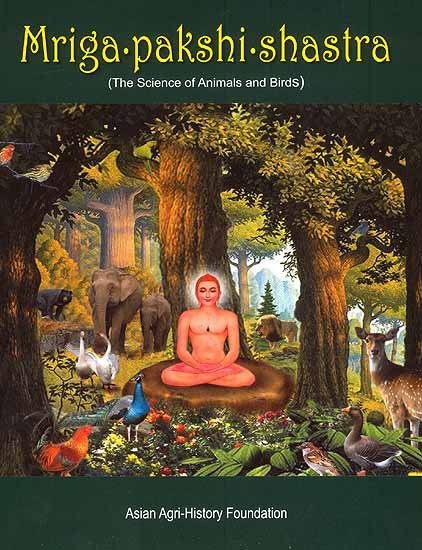Animal Kingdom (Tiryak) in Epics
by Saranya P.S | 2019 | 51,616 words | ISBN-10: 8190396315 | ISBN-13: 9788190396318
An English study the Animal Kingdom (Tiryak) in Epics.—The present thesis is based entirely on Ramayana and Mahabharata although an attempt is made to analytically compare the Animal kingdom with Mriga-pakshi-shastra—‘The ancient Indian science of of Animals and Birds’....
Chapter 3.13 - Minor Monkey characters
In Ramayana, there is so many monkey characters included by the author. Some of them are shows their place with their characteristics.
Dadhivakra
This monkey who helped Rama was the uncle of Sugriva.[1]
Gaja
Gaja is a bold monkey leader. It is said that he fought on behalf of the cause of Rama.[2]
Gavaksha
He is a courageous monkey chief. It is said that he helped Rama with an army of 60,000 monkeys.[3]
Gavaya
Gavaya is an adventurous and powerful monkey king. In the Rama-Ravana battle, he led an army against Ravana, fighting for the cause of Rama.[4]
Kumuda
Kumuda was the servant of Sugriva.[5]
Mainda
In the Rama-Ravana battle, Mainda is a monkey that helped Shri Rama. Mainda used to live in Kishkindha. While he was dwelling there, once Sahadeva came that way after making his Southern World Victory. He fought with Mainda for 7 days. But he could not defeat Mainda. However Mainda was happy with Sahadeva and he presented many invaluable gems to him and asked him not to put any obstacle on the way of Dharmaputra’s efforts.[6] Mainda was a minister of Sugriva. He was very generous, intelligent and strong.[7] He led the monkey troupe that was going in search of Sita.[8] In the Rama-Ravana battle, we see that the unconscious Lakshmana and others washed their faces with the water Kubera gave them and then they were able to see the hidden creatures. Mainda had also washed his face with the water given by Kubera.[9]
Riksharajas
Riksharajas is the foster-father of Bali and Sugriva. He was the king of Kishkindha but he did not have any children. In the Uttrara Ramayana is it is said that Riksharajas received Bali and Sugriva as his sons with the permission of Indra. Bali and Sugriva were under the care of Ahalyadevi in Gautamashrama.
Once when Brahma was immersed in meditation on the Meru Mountain, tears fell down from his eyes. He collected the tears in his hands. From those tears, a monkey was born. This was Riksharajas.[10]
Shatabali
He was a monkey under the leadership of Sugriva. It was Shatabali who led the monkey troupe that went northward in search of Sita.[11]
Sushena
He is Bali’s father in law. As the father of Tara, he also took part in the search for Sita leading a large troupe of monkeys.[12] He was the son of the monkey called Dharma and he was well-versed in the art of medicine and martial arts.
In the Rama-Ravana Battle Sushena faced the monster troupe and killed Vidyunmali. When Indrajit was killed, Ravana came on the scene and by his arrows Lakshmana and many other monkeys were wounded and became unconscious. As Sushena was an expert in medicines, he revived them by using herbs like ‘vishalyakarani’, ‘savarnyakarani’, ‘sanjivani’, etc.[13] Sushena was also present during the coronation of Shrirama.[14]
Tara
Tara was the son of Brihaspati who was a follower of Shri Rama.[15] According to Uttara Ramayana, Tara was the Minister of Bali. In the Rama-Ravana Battle, it is said that he fought with the giant named Niharvada.[16]
Vinata
Vinata was a monkey commander who led the monkey force that went to the east to search for Sita. He was the son of Shveta and under his command there were nearly a hundred thousand monkeys.[17]
Footnotes and references:
[1]:
Adhyatma Ramayana .V.5
[2]:
Mahabharata .vanaparva.273.3
[3]:
Ibid 283.4
[4]:
Ibid 283.3
[5]:
Ibid 289.4
[6]:
Ibid Sabhaparva 31.8
[7]:
Ibid vanaparva 280.23
[8]:
Ibid 267.19
[9]:
Ibid.289.19
[10]:
Valmiki Ramayana Uttara Prakshiptasarga
[11]:
Valmiki Ramayana IV.43
[12]:
Mahabharata vanaparva.283.2
[13]:
Valmiki Ramayana .V.101
[14]:
Ibid 128.54
[15]:
Ibid I.17.10
[16]:
Mahabharata .vanaparva.285.9
[17]:
Valmiki Ramayana VI.26
